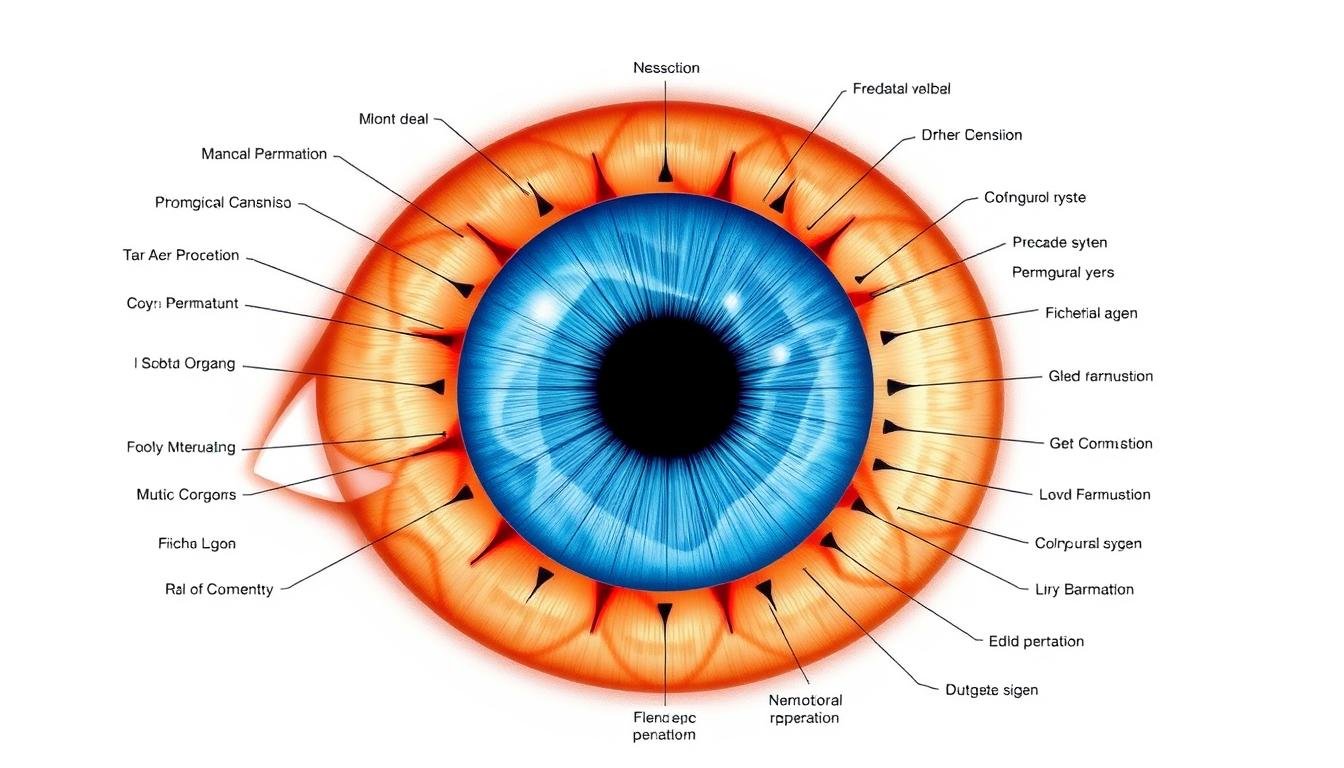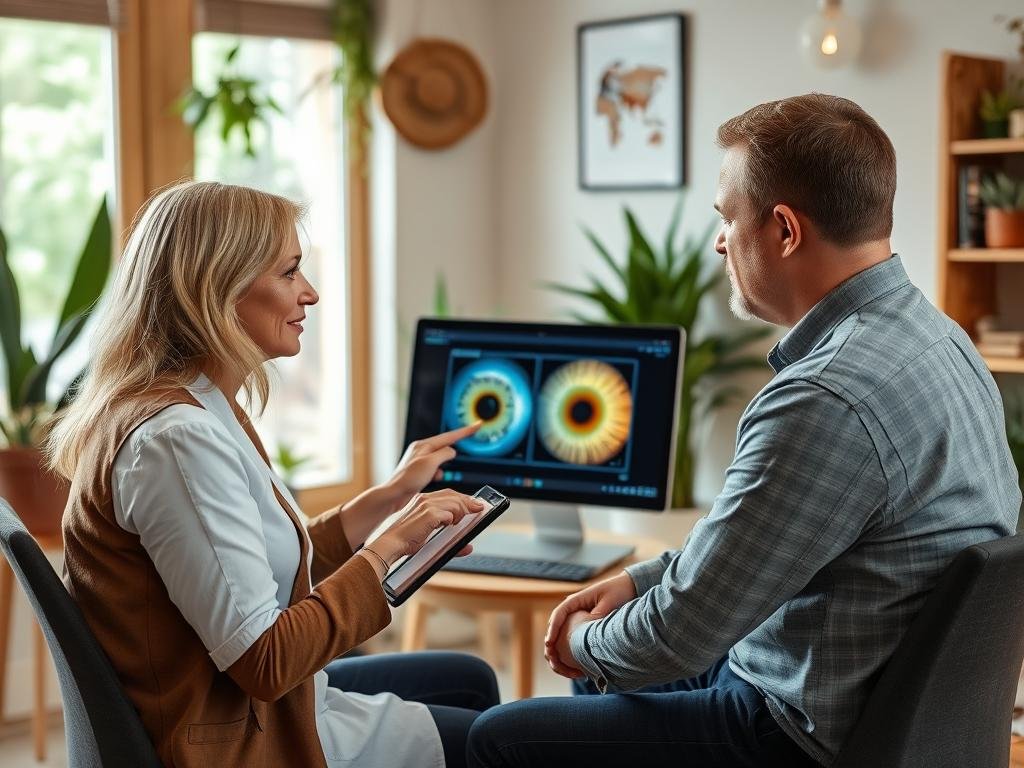Understanding Diagnóstico da IRIS de iridologia: Principles and Foundations
A standard iridology chart mapping iris regions to body systems
Diagnóstico da IRIS de iridologia is based on the premise that the iris contains a detailed map of the body, with each section corresponding to specific organs and systems. Practitioners believe that changes in iris color, pattern, and structure can indicate inflammation, toxin accumulation, or organ dysfunction in corresponding body areas. The practice involves examining the iris through magnification and comparing findings to standardized charts that divide the iris into zones representing different body parts.
The foundation of modern Diagnóstico da IRIS de iridologia is often attributed to Hungarian physician Ignatz von Peczely, who in the 1860s noticed changes in an owl’s iris after it suffered a broken leg. This observation led him to develop the first comprehensive iris chart. However, similar diagnostic methods appear in ancient Chinese and Egyptian texts, suggesting the practice has much older roots.
“The eyes are not only windows to the soul but also mirrors reflecting the state of our physical body. Diagnóstico da IRIS de iridologia allows us to read these reflections and understand the body’s language.”
– Dr. Bernard Jensen, Pioneering American Iridologist
Today’s iridologists use several key principles when conducting an examination:
- The left iris corresponds to the left side of the body
- The right iris corresponds to the right side of the body
- The iris is divided into approximately 80-90 zones
- Changes in color, fiber structure, and markings indicate potential health concerns
- The iris reveals constitutional strengths and weaknesses, not specific diseases
Discover Your Body’s Hidden Messages
Curious about what your iris might reveal about your health? Download our free introductory guide to Diagnóstico da IRIS de iridologia and begin understanding the basics of this fascinating practice.
Baixe o guia grátis
Global Practices of Diagnóstico da IRIS de iridologia: Regional Variations
European Diagnóstico da IRIS de iridologia Traditions
Europe remains the heartland of Diagnóstico da IRIS de iridologia, with Germany, Russia, and the United Kingdom hosting thriving communities of practitioners. German iridology, influenced by naturopathic physician Josef Deck, tends to be highly systematic and detailed. German practitioners often integrate iridology with other natural healing modalities and focus on constitutional assessment rather than disease diagnosis.
In Russia, Diagnóstico da IRIS de iridologia has gained significant acceptance within some medical institutions, with practitioners often having conventional medical backgrounds. Russian iridologists frequently combine iris analysis with other diagnostic methods and may use specialized computer software to enhance accuracy.
Asian Approaches to Diagnóstico da IRIS de iridologia
In Asia, Diagnóstico da IRIS de iridologia often integrates with traditional medicine systems. Chinese iridologists frequently combine iris analysis with Traditional Chinese Medicine principles, examining the iris alongside pulse diagnosis and tongue inspection. This holistic approach considers the iris as just one component of a comprehensive health assessment.
Japan has developed a unique approach to Diagnóstico da IRIS de iridologia that emphasizes technological innovation. Japanese practitioners often use advanced digital imaging systems that can detect subtle iris changes invisible to the naked eye. These systems may incorporate artificial intelligence to assist with analysis and pattern recognition.
Americas: Blending Tradition with Innovation
In North America, Diagnóstico da IRIS de iridologia gained popularity largely through the work of Dr. Bernard Jensen in the mid-20th century. American iridology tends to be more entrepreneurial, with practitioners often operating independent clinics or integrating iris analysis into broader holistic health practices. There’s also a strong emphasis on educational outreach, with numerous certification programs available.
South American countries, particularly Brazil and Argentina, have embraced Diagnóstico da IRIS de iridologia as part of their integrative health movements. In these regions, the practice often incorporates indigenous healing traditions alongside European methods, creating unique hybrid approaches.
Explore Diagnóstico da IRIS de iridologia With an Expert
Interested in experiencing an iris reading? Connect with a certified iridologist in your area to discover what your eyes might reveal about your health.
Find an Iridologist Near You
Modern Techniques and Tools in Diagnóstico da IRIS de iridologia
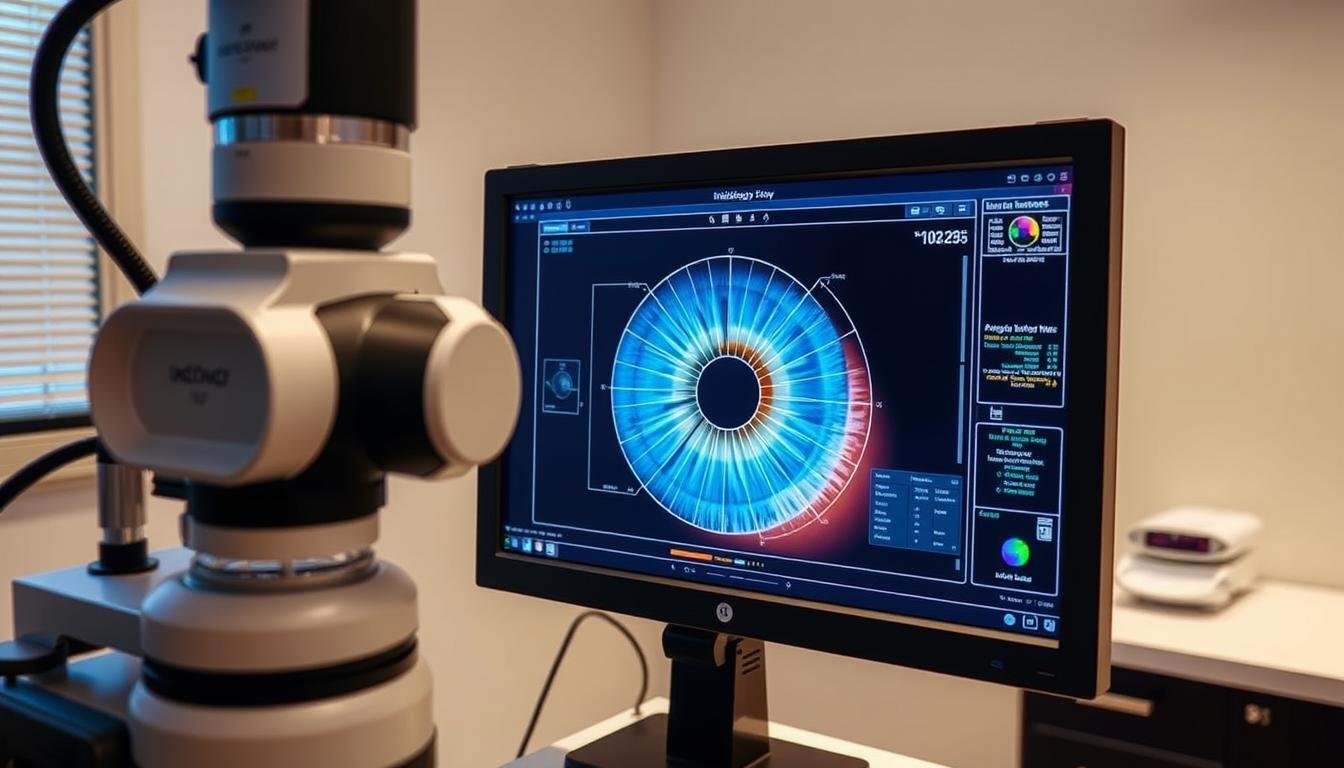
Advanced digital iridology system with analysis software
The practice of Diagnóstico da IRIS de iridologia has evolved significantly with technological advancements. Today’s practitioners utilize sophisticated tools that enhance accuracy and provide detailed documentation of findings.
Digital Imaging in Diagnóstico da IRIS de iridologia
High-resolution digital cameras specifically designed for iris photography have revolutionized the field. These specialized cameras can capture minute details in the iris that might be missed during manual examination. Digital images can be enlarged, enhanced, and analyzed with precision, allowing practitioners to track subtle changes over time.
Software applications dedicated to Diagnóstico da IRIS de iridologia now offer automated analysis features. These programs can map the iris according to standard charts, highlight areas of interest, and even suggest potential health concerns based on established patterns. Some advanced systems incorporate machine learning algorithms that improve accuracy with continued use.
Examination Protocols and Standards
Moderno Diagnóstico da IRIS de iridologia has developed standardized examination protocols to ensure consistency. A typical session now includes:
- Client health history review
- Digital photography of both irises
- Analysis using standardized charts and software
- Consultation to discuss findings
- Integration with other health assessments
- Development of personalized health recommendations
Professional organizations like the International Iridology Practitioners Association (IIPA) and the Guild of Naturopathic Iridologists have established practice standards and ethical guidelines. These organizations offer certification programs that require practitioners to demonstrate proficiency in both theoretical knowledge and practical application.

Mobile applications have made basic iridology analysis more accessible
Accessibility and Consumer Applications
The democratization of Diagnóstico da IRIS de iridologia has accelerated with smartphone applications that allow users to capture and analyze their own irises. While these consumer tools lack the precision and expertise of professional analysis, they have introduced the concept to a broader audience and sparked interest in the practice.
Note: Consumer iridology apps should not replace professional consultation. These tools are best used as educational resources rather than diagnostic instruments.
Stay Updated on Diagnóstico da IRIS de iridologia Advancements
Join our newsletter to receive the latest information on technological developments, research findings, and practice innovations in the field of iridology.
Subscribe to Updates
Case Studies: Diagnóstico da IRIS de iridologia in Practice
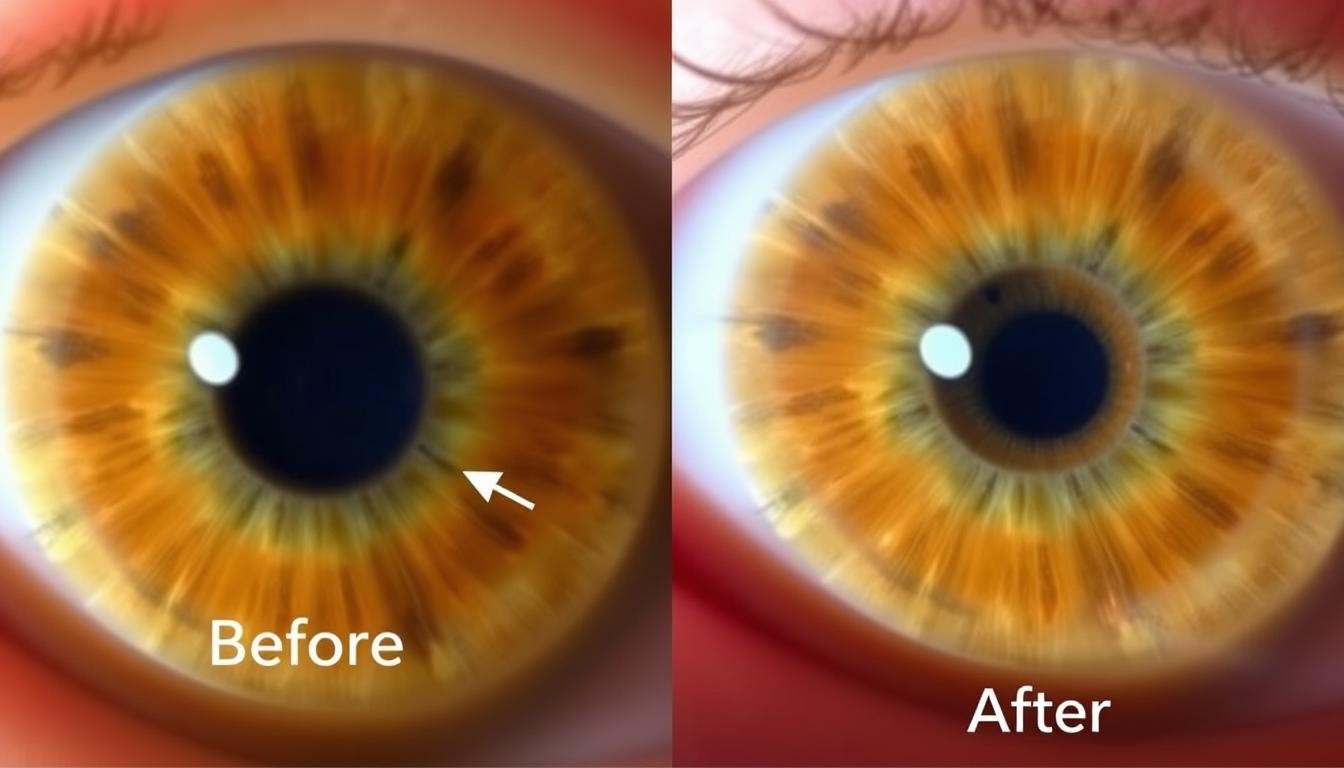
Before and after iris images showing changes following nutritional interventions
To better understand how Diagnóstico da IRIS de iridologia works in real-world settings, let’s examine several case studies from practitioners around the world. These examples illustrate the application of iridology principles across different health concerns.
Estudo de caso 1: Avaliação de Saúde Digestiva
A 42-year-old woman in Germany sought Diagnóstico da IRIS de iridologia after experiencing chronic digestive discomfort. The iridologist noted distinct markings in the intestinal zone of her iris, suggesting inflammation and potential food sensitivities. Based on these observations, the practitioner recommended an elimination diet and specific herbal supplements.
After three months, follow-up iris photography showed reduced inflammation markers, correlating with the client’s reported improvement in symptoms. This case demonstrates how iridology can help identify potential areas of concern and guide targeted interventions.
Case Study 2: Constitutional Assessment in Preventive Care
A wellness clinic in Japan incorporated Diagnóstico da IRIS de iridologia into their preventive health screenings. One notable case involved a 55-year-old man with no current health complaints. Iris analysis revealed constitutional weaknesses in the cardiovascular zones, prompting additional testing that uncovered early signs of hypertension.
The client was able to implement lifestyle modifications before symptoms developed, potentially preventing more serious complications. This case highlights the preventive potential of iridology when used as part of a comprehensive health assessment.
Case Study 3: Integrative Approach in Brazil
A Brazilian integrative health center documented the case of a 38-year-old client with chronic fatigue. The Diagnóstico da IRIS de iridologia revealed signs of adrenal stress and potential thyroid imbalance. Rather than relying solely on iris analysis, the practitioners used these findings to guide conventional laboratory testing, which confirmed subclinical hypothyroidism.
This integrated approach led to a comprehensive treatment plan combining conventional medical care with supportive natural therapies. Six months later, both subjective improvements and changes in the iris were documented, demonstrating the complementary role iridology can play in integrative healthcare.
| Case Location |
Primary Finding |
Intervention Approach |
Outcome Measurement |
| Alemanha |
Intestinal inflammation markers |
Elimination diet, herbal supplements |
Reduced iris markings, symptom improvement |
| Japão |
Cardiovascular constitutional weakness |
Additional testing, lifestyle modifications |
Prevention of hypertension progression |
| Brasil |
Adrenal stress, thyroid imbalance signs |
Integrated conventional and natural therapies |
Improved energy, iris changes, lab values |
Experiência Diagnóstico da IRIS de iridologia Em primeira mão
Ready to discover what your iris might reveal about your health? Schedule a consultation with a certified iridologist to receive a personalized assessment.
Reserve uma consulta
Scientific Perspective on Diagnóstico da IRIS de iridologia

Scientific evaluation of iridology continues to evolve with new research
The scientific community maintains a cautious stance toward Diagnóstico da IRIS de iridologia. Conventional medicine has questioned its diagnostic validity, citing limited empirical evidence and the absence of a clear physiological mechanism to explain how internal organ conditions would manifest in iris patterns.
Research Findings and Limitations
Several controlled studies have examined the diagnostic accuracy of iridology with mixed results. A systematic review published in the European Journal of Ophthalmology found insufficient evidence to support iridology as a diagnostic tool for specific diseases. However, proponents argue that these studies often misunderstand the fundamental purpose of iridology—which is to identify constitutional tendencies rather than diagnose specific conditions.
Supportive Research
- Some studies have found correlations between iris signs and certain health conditions
- Research in Russia has documented changes in iris patterns following known health events
- Case series reports suggest potential value in constitutional assessment
Critical Research
- Controlled trials show limited diagnostic accuracy for specific diseases
- Lack of standardization across practitioners raises reliability concerns
- Physiological mechanism for iris-organ connection remains unclear
Bridging Traditional and Conventional Approaches
Some healthcare institutions are exploring integrative models that incorporate Diagnóstico da IRIS de iridologia alongside conventional assessments. This approach acknowledges the potential complementary role of iridology while maintaining the primacy of evidence-based diagnostics for clinical decision-making.
Researchers at several universities are conducting more nuanced investigations that align with how iridology is actually practiced—focusing on constitutional assessment rather than disease diagnosis. These studies may provide more relevant insights into the potential value of iris analysis as part of a holistic health evaluation.
Perspective: While scientific validation of Iridologia Iris Diagnosis remains limited, many practitioners and clients report value in its use as a complementary assessment tool. The practice may be best understood as one component of a comprehensive approach to health rather than as a standalone diagnostic method.
Learning Diagnóstico da IRIS de iridologia: Education and Certification
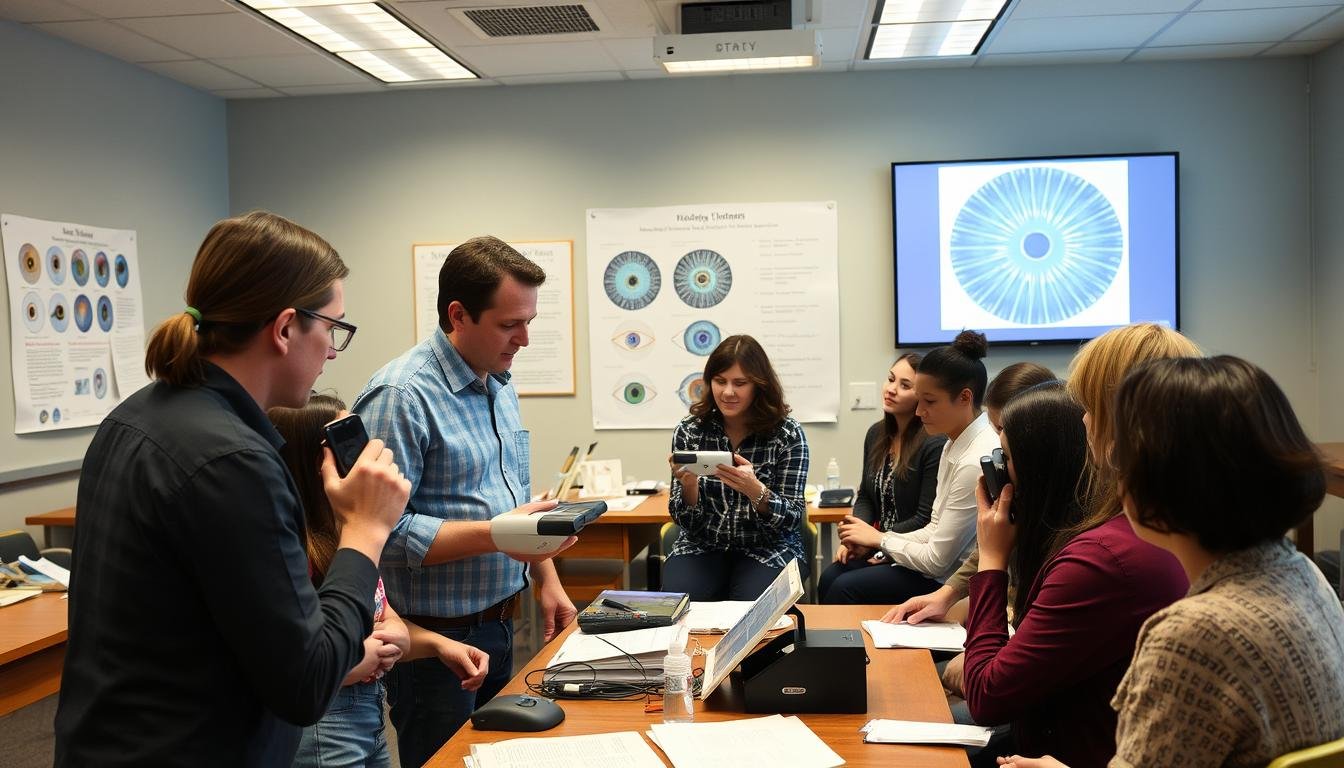
Professional iridology training combines theoretical knowledge with practical skills
For those interested in practicing Diagnóstico da IRIS de iridologia, proper education and training are essential. The field offers various pathways for learning, from introductory workshops to comprehensive certification programs.
Educational Pathways
Training in Diagnóstico da IRIS de iridologia typically includes:
- Fundamentals of iris topography and chart systems
- Identification of iris signs and their potential significance
- Proper examination techniques and equipment use
- Client consultation skills and ethical considerations
- Integration with other health assessment methods
- Case study analysis and practical application
Certification Organizations
Several international organizations offer certification in Diagnóstico da IRIS de iridologia. These include:
Associação Internacional de Profissionais de Iridologia (IIPA)
Offers comprehensive certification programs with multiple levels of achievement. IIPA certification is recognized globally and requires both theoretical knowledge and practical demonstration of skills.
Guild of Naturopathic Iridologists
Based in the UK but with international reach, this organization provides training that integrates iridology with broader naturopathic principles. Their certification is well-respected in Europe.
Instituto Canadense de Iridologia
Offers both in-person and distance learning options with a focus on practical application. Their programs emphasize the integration of iridology with other natural health modalities.
Educação continuada
The field of Diagnóstico da IRIS de iridologia continues to evolve, making ongoing education important for practitioners. Advanced courses, specialized workshops, and international conferences provide opportunities to refine skills and stay current with developments in the field.
Many practitioners also pursue complementary studies in nutrition, herbology, or other natural health disciplines to enhance their ability to provide comprehensive guidance based on iris findings.
Begin Your Journey in Diagnóstico da IRIS de iridologia
Ready to explore the fascinating world of iris analysis? Access our comprehensive directory of accredited training programs and start your educational journey today.
Explore Training Programs
The Future of Diagnóstico da IRIS de iridologia in Global Healthcare
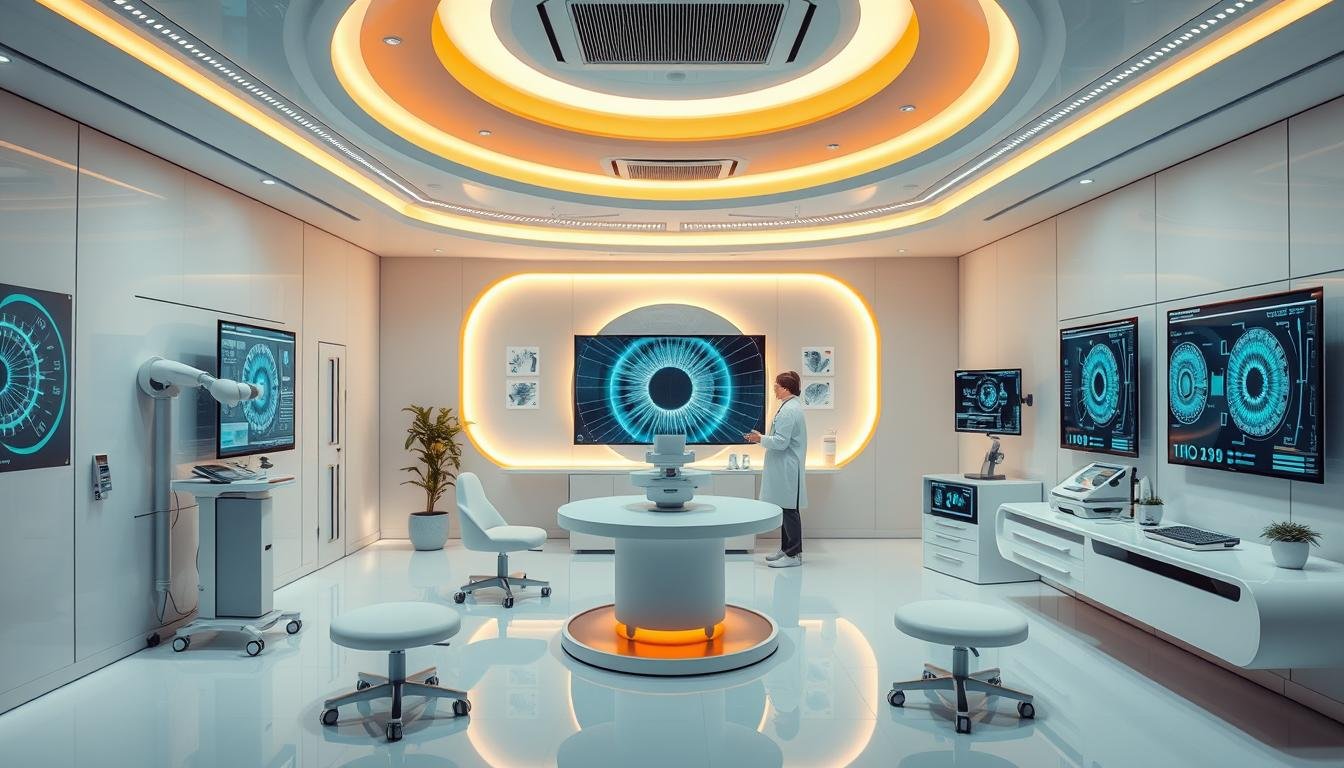
The integration of technology and traditional knowledge shapes the future of iridology
As we look to the future, Diagnóstico da IRIS de iridologia stands at a crossroads between traditional practice and modern innovation. Several trends suggest how this ancient art might evolve in the coming years:
- Technological integration will likely continue, with artificial intelligence enhancing pattern recognition and analysis capabilities
- Research methodologies may evolve to better evaluate iridology on its own terms, focusing on constitutional assessment rather than disease diagnosis
- Integrative healthcare models may increasingly incorporate iridology as one component of comprehensive wellness assessment
- Standardization efforts will likely expand to improve consistency across practitioners and enhance credibility
Enquanto Diagnóstico da IRIS de iridologia may never achieve universal acceptance within conventional medicine, its persistence across cultures and centuries suggests it offers something of value to those who practice and experience it. As with many traditional health practices, the wisdom of iridology may lie in its holistic perspective—seeing the body as an interconnected system rather than isolated parts.
Whether you approach Diagnóstico da IRIS de iridologia as a practitioner, a client, or a curious observer, understanding its global practice provides insight into how different cultures approach health assessment and the enduring human desire to read the body’s subtle signals before disease manifests.
Continue Your Diagnóstico da IRIS de iridologia Journey
Ready to learn more or experience iridology firsthand? Connect with our network of certified practitioners or explore our educational resources to deepen your understanding of this fascinating practice.
Connect With Specialists















